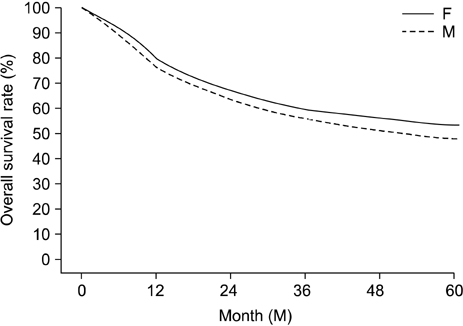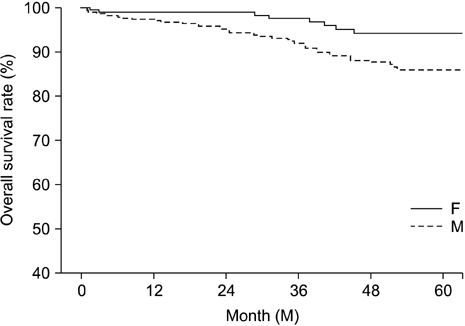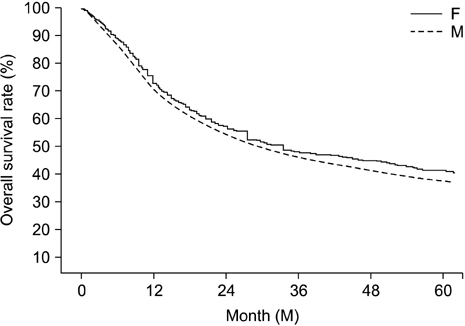Chonnam Med J.
2012 Aug;48(2):86-90. 10.4068/cmj.2012.48.2.86.
Clinicopathological Features of Female Gastric Carcinoma Patients with Curative Resection: Comparison with Male Patients
- Affiliations
-
- 1Division of Gastroenterologic Surgery, Department of Surgery, Chonnam National University Medical School, Gwangju, Korea. dockim@chonnam.ac.kr
- KMID: 2172208
- DOI: http://doi.org/10.4068/cmj.2012.48.2.86
Abstract
- Little is known about the clinicopathological features of female gastric carcinoma (FGC) patients. We compared the clinicopathologic features and outcomes of FGC patients with curative resection with those of male gastric carcinoma (MGC) patients. We reviewed the hospital records of 940 FGC patients between 1986 and 2005 at Chonnam National University Hospital. Multivariate analysis showed that presence of serosal invasion, lymph node metastasis, and operative type were significant prognostic factors for survival of FGC patients with curative resection. Furthermore, the overall 5-year survival rate of FGC patients with curative resection (53.4%) was higher than that of MGC patients (47.6%, p<0.05). In advanced cases, no significant difference was observed in the overall 5-year survival rate between the FGC and MGC patients (41.6% vs 37.4%, p>0.05). Therefore, serosal invasion, lymph node metastasis, and type of operation were statistically significant parameters associated with survival. Early detection is more important for improving the prognosis of female patients with gastric cancer than for male patients.
MeSH Terms
Figure
Reference
-
1. Sipponen P, Correa P. Delayed rise in incidence of gastric cancer in females results in unique sex ratio (M/F) pattern: etiologic hypothesis. Gastric Cancer. 2002. 5:213–219.
Article2. Bozzetti F, Bonfanti G, Morabito A, Bufalino R, Menotti V, Andreola S, et al. A multifactorial approach for the prognosis of patients with carcinoma of the stomach after curative resection. Surg Gynecol Obstet. 1986. 162:229–234.3. Korenaga D, Haraguchi M, Okamura T, Baba H, Saito A, Sugimachi K. DNA ploidy and tumor invasion in human gastric cancer. Histopathologic differentiation. Arch Surg. 1989. 124:314–318.
Article4. Sato N, Ito Y, Ioka A, Tanaka M, Tsukuma H. Gender differences in stomach cancer survival in Osaka, Japan: analyses using relative survival model. Jpn J Clin Oncol. 2009. 39:690–694.
Article5. American Joint Committee on Cancer. AJCC cancer staging manual. 2002. 6th ed. Springer-Verlag.6. Japanese Gastric Cancer Association. Japanese Classification of Gastric Carcinoma - 2nd English Edition. Gastric Cancer. 1998. 1:10–24.7. Maguire A, Porta M, Sanz-Anquela JM, Ruano I, Malats N, Piñol JL. Sex as a prognostic factor in gastric cancer. Eur J Cancer. 1996. 32A:1303–1309.
Article8. Kim JH, Boo YJ, Park JM, Park SS, Kim SJ, Kim CS, et al. Incidence and long-term outcome of young patients with gastric carcinoma according to sex: does hormonal status affect prognosis? Arch Surg. 2008. 143:1062–1067.
Article9. Freedman ND, Chow WH, Gao YT, Shu XO, Ji BT, Yang G, et al. Menstrual and reproductive factors and gastric cancer risk in a large prospective study of women. Gut. 2007. 56:1671–1677.
Article10. Chandanos E, Lagergren J. Oestrogen and the enigmatic male predominance of gastric cancer. Eur J Cancer. 2008. 44:2397–2403.
Article11. Yu J, Zhao Q. The demographic characteristics of histological types of gastric cancer with gender, age, and tumor location. J Gastrointest Cancer. 2009. 40:98–100.
Article12. Moriguchi S, Odaka T, Hayashi Y, Nose Y, Maehara Y, Korenaga D, et al. Death due to recurrence following curative resection of early gastric cancer depends on age of the patient. Br J Cancer. 1991. 64:555–558.
Article13. Takeda J, Tanaka T, Koufuji K, Kodama I, Tsuji Y, Kakegawa T. Gastric cancer surgery in patients aged at least 80 years old. Hepatogastroenterology. 1994. 41:516–520.14. Adachi Y, Mori M, Maehara Y, Kitano S, Sugimachi K. Prognostic factors of node-negative gastric carcinoma: univariate and multivariate analyses. J Am Coll Surg. 1997. 184:373–377.15. Bando E, Kojima N, Kawamura T, Takahashi S, Fukushima N, Yonemura Y. Prognostic value of age and sex in early gastric cancer. Br J Surg. 2004. 91:1197–1201.
Article16. Schafmayer C, Jürgens G, Jürgens I, Klomp HJ, Fändrich F, Kahlke V. Long-term survival of curatively operated gastric cancer: influence of the gender and splenectomy. Zentralbl Chir. 2007. 132:515–522.17. Kim J, Cheong JH, Hyung WJ, Shen J, Choi SH, Noh SH. Predictors of long-term survival in pN3 gastric cancer patients. J Surg Oncol. 2004. 88:9–13.
Article
- Full Text Links
- Actions
-
Cited
- CITED
-
- Close
- Share
- Similar articles
-
- The Benefits of Resection for Gastric Carcinoma Patients with Non-curative Factors
- The Prognosis of Patients with Stage IV Gastric Carcinoma without Distant Metastasis
- Clinicopathological Features of Borrmann Type IV Gastric Carcinomas
- Clinicopathological Analysis of Recurrent Gastric Cancer after Curative Resection
- Clinicopathologic Characteristics of and Prognosis for Patients with a Borrmann Type IV Gastric Carcinoma




